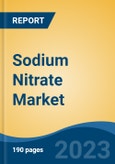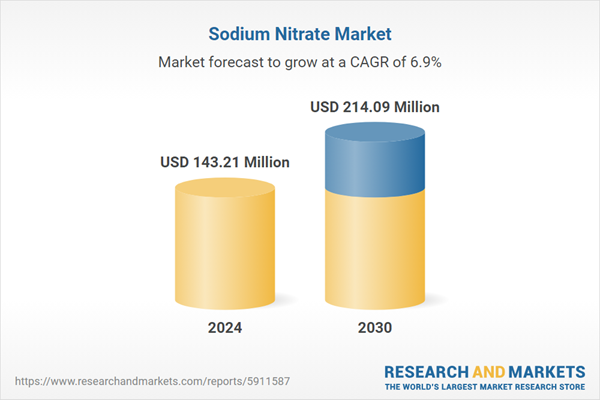Speak directly to the analyst to clarify any post sales queries you may have.
10% Free customizationThis report comes with 10% free customization, enabling you to add data that meets your specific business needs.
One of the major driving forces behind the growth of the sodium nitrate market is its increasing use in fertilizers. As a highly soluble nitrogen source, sodium nitrate plays a vital role in enhancing soil fertility and promoting healthy crop growth, especially in arid and semi-arid regions. With the global population on the rise and food security becoming a critical concern, demand for high-efficiency fertilizers has surged. Sodium nitrate’s fast-acting nature and compatibility with other nutrients make it a preferred choice in the agricultural sector, particularly in regions like Asia-Pacific and Latin America, where agricultural intensification is rapidly advancing.
Key Market Drivers
Growing Agricultural Demand for Fertilizers
The rising global population, projected to exceed 9.7 billion by 2050, is placing immense pressure on the agricultural sector to increase food production. This has resulted in heightened demand for high-efficiency fertilizers like sodium nitrate, which supports faster and more targeted nutrient delivery. According to 2023 data, global nitrogen fertilizer consumption reached over 110 million metric tons, indicating a steady uptick in nutrient-intensive farming practices. Sodium nitrate’s nitrogen-rich composition makes it especially valuable in regions with nutrient-depleted soils or where fast-acting nutrient availability is required to meet production targets.Sodium nitrate’s high solubility and quick nitrogen release rate give it an edge over other nitrogen fertilizers. It dissolves easily in irrigation water and is readily absorbed by plants, making it suitable for fertigation and precision farming applications. In 2023, fertigation-based farming expanded by 12% globally, signaling increased farmer interest in water-efficient, nutrient-targeted methods. This growth directly supports the adoption of soluble fertilizers like sodium nitrate, which aligns with the demands of modern farming techniques that prioritize yield, nutrient efficiency, and rapid crop response.
Besides improving crop productivity, sodium nitrate enhances the quality of agricultural output. Nitrogen plays a key role in chlorophyll production, leaf expansion, and root development, contributing to healthier and more resilient crops. Trials conducted across European farmlands in 2023 revealed that crops treated with sodium nitrate exhibited a 15-20% improvement in overall biomass and harvest quality compared to non-treated plots. These improvements are critical for farmers focused on not just meeting yield targets but also producing export-grade or value-added crops for global markets.
Furthermore, sodium nitrate supports sustainable agriculture by minimizing environmental harm associated with over-fertilization. Its compatibility with precision agriculture allows for controlled nutrient release, thereby reducing nutrient leaching and runoff into water bodies. A 2022 study found that farms using sodium nitrate in drip irrigation systems saw a 25% reduction in nitrate pollution compared to those using conventional urea. This eco-friendly profile, coupled with rising awareness about soil and water conservation, is making sodium nitrate a preferred choice among environmentally conscious growers worldwide.
Key Market Challenges
Health and Safety Concerns
The global sodium nitrate market, a crucial component of various industries, including agriculture and food preservation, faces significant challenges driven by health and safety concerns. Sodium nitrate, while versatile and valuable, has come under scrutiny due to potential risks associated with its use, particularly in food processing and preservation.Sodium nitrate is added to these products to inhibit bacterial growth, extend shelf life, and maintain the appealing pink color. However, when sodium nitrate interacts with certain components in food, such as amino acids and cooking at high temperatures, it can lead to the formation of nitrosamines. Nitrosamines are a class of compounds known to be potentially carcinogenic, and this association has raised alarm among health-conscious consumers and regulatory bodies.
As public awareness of the potential health risks of nitrosamines has grown, there has been a shift in consumer preferences towards cleaner and more natural food products. Manufacturers have faced pressure to explore alternative methods of preserving processed meats without relying on synthetic preservatives like sodium nitrate. This shift in consumer sentiment has the potential to impact the sodium nitrate market, as food manufacturers seek to reformulate their products to align with evolving health and safety concerns.
Regulatory bodies in various countries have also responded to these health and safety concerns by imposing stricter regulations and limits on the use of sodium nitrate in food products. These regulations aim to reduce the potential formation of nitrosamines and protect public health.
Key Market Trends
Growing Agricultural Demand for Fertilizers
The global sodium nitrate market is witnessing a notable upsurge in demand, driven primarily by the ever-growing agricultural need for fertilizers. This surge is a direct response to the relentless global population growth and the escalating requirement for increased food production to ensure food security. Sodium nitrate, renowned for its rich nitrogen content, plays a pivotal role in addressing this agricultural challenge.The agricultural sector has emerged as a key driver for the sodium nitrate market due to its crucial role in enhancing crop yields. Sodium nitrate's solubility in water makes it an exceptionally efficient nitrogen source for plants. This characteristic allows plants to readily absorb the vital nutrients, resulting in robust growth and development. As nitrogen stands as a cornerstone nutrient essential for plant growth, sodium nitrate has become the fertilizer of choice for many farmers worldwide.
Furthermore, sodium nitrate's use in agriculture offers numerous advantages. It not only bolsters crop yields but also contributes to the quality of harvested produce. This is particularly crucial in the context of global food security, where the quality of food products is just as critical as quantity. Sodium nitrate facilitates consistent and balanced nitrogen supply, which supports healthy foliage, root development, and overall plant vigor.
The intensifying demand for fertilizers, especially those rich in nitrogen, is a direct consequence of the global commitment to address the challenges posed by a burgeoning population and the necessity for sustainable agricultural practices. In light of this, sodium nitrate remains a trusted and sought-after fertilizer, contributing significantly to agricultural productivity and global food security.
Key Market Players
- Deepak Nitrate Limited
- SQM S.A.
- BASF SE
- Weifang Haiye Chemistry and Industry Co
- Acf Nitratos S.A
- Quality Chemicals S.L
- Shijizhuang Fengshan Chemical Co. Ltd.
- Ural Chem JSC
- UBE Industries Ltd.
- AG CHEMI GROUP s.r.o
Report Scope:
In this report, the Global Sodium Nitrate Market has been segmented into the following categories, in addition to the industry trends which have also been detailed below:Sodium Nitrate Market, By Grade:
- Industrial
- Pharmaceutical
- Food
Sodium Nitrate Market, By Application:
- Chemicals
- Fertilizers
- Explosives
- Glass
- Pharmaceuticals
- Food & Beverages
- Others
Sodium Nitrate Market, By Region:
- North America
- United States
- Canada
- Mexico
- Europe
- France
- United Kingdom
- Italy
- Germany
- Spain
- Asia-Pacific
- China
- India
- Japan
- Australia
- South Korea
- South America
- Brazil
- Argentina
- Colombia
- Middle East & Africa
- South Africa
- Saudi Arabia
- UAE
Competitive Landscape
Company Profiles: Detailed analysis of the major companies present in the Global Sodium Nitrate Market.Available Customizations:
With the given market data, the publisher offers customizations according to a company's specific needs. The following customization options are available for the report.Company Information
- Detailed analysis and profiling of additional market players (up to five).
Table of Contents
Companies Mentioned
- Deepak Nitrate Limited
- SQM S.A.
- BASF SE
- Weifang Haiye Chemistry and Industry Co
- Acf Nitratos S.A
- Quality Chemicals S.L
- Shijizhuang Fengshan Chemical Co. Ltd.
- Ural Chem JSC
- UBE Industries Ltd.
- AG CHEMI GROUP s.r.o
Table Information
| Report Attribute | Details |
|---|---|
| No. of Pages | 190 |
| Published | August 2025 |
| Forecast Period | 2024 - 2030 |
| Estimated Market Value ( USD | $ 143.21 Million |
| Forecasted Market Value ( USD | $ 214.09 Million |
| Compound Annual Growth Rate | 6.8% |
| Regions Covered | Global |
| No. of Companies Mentioned | 10 |









